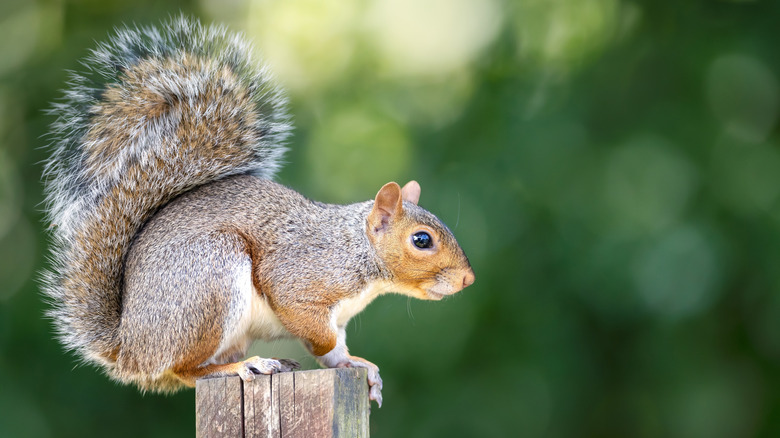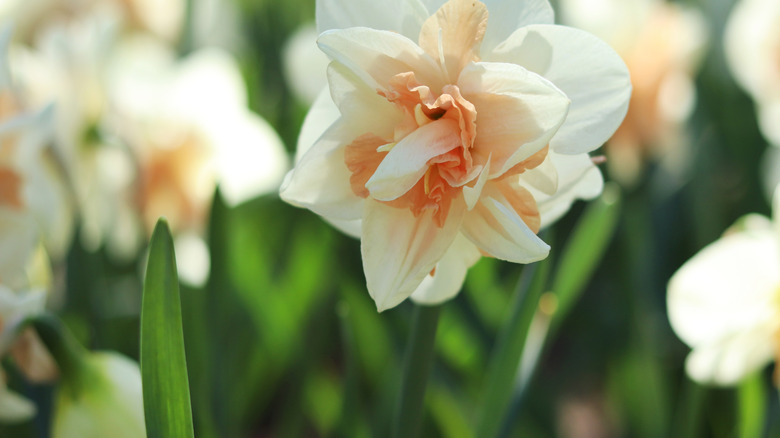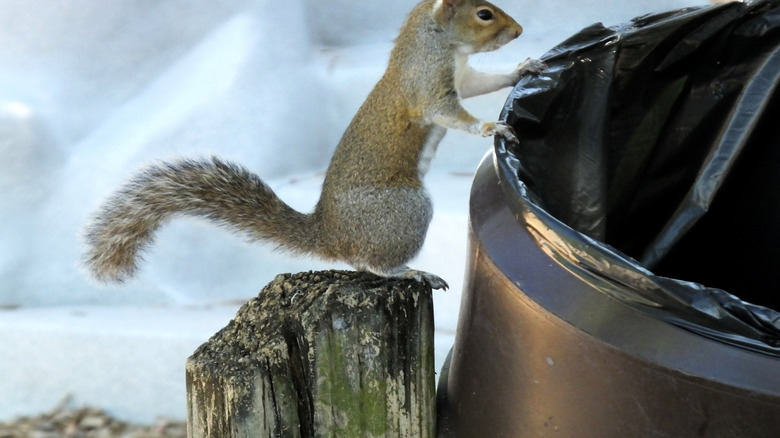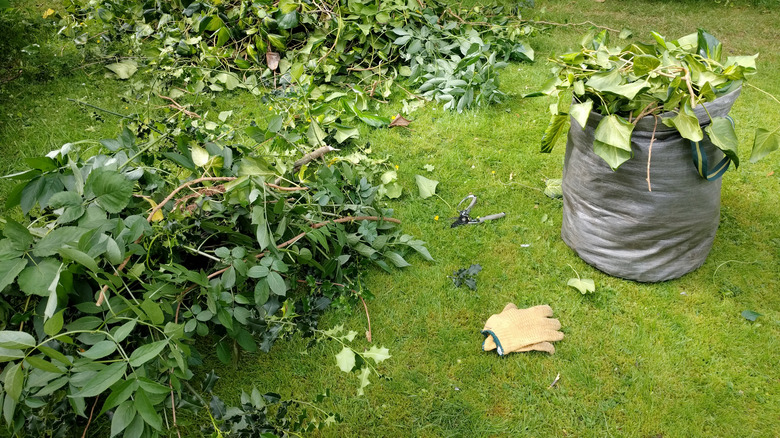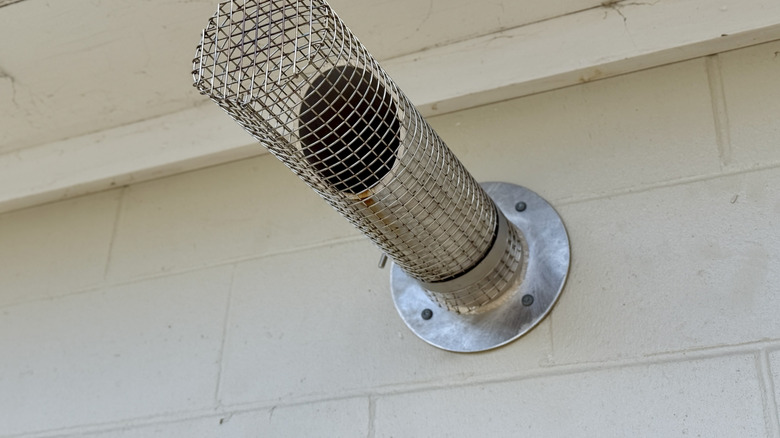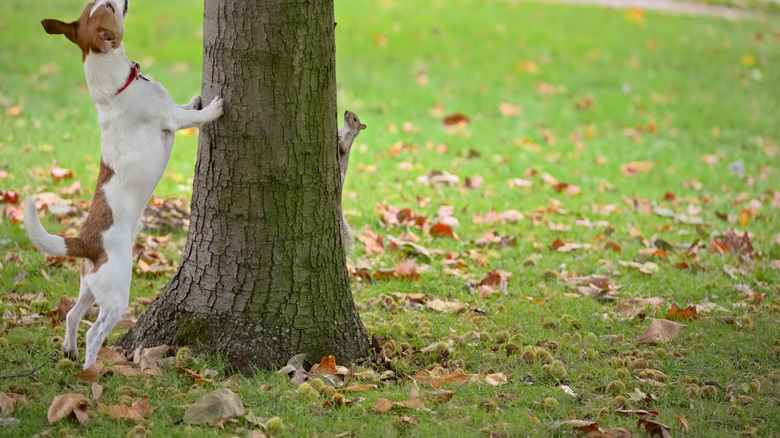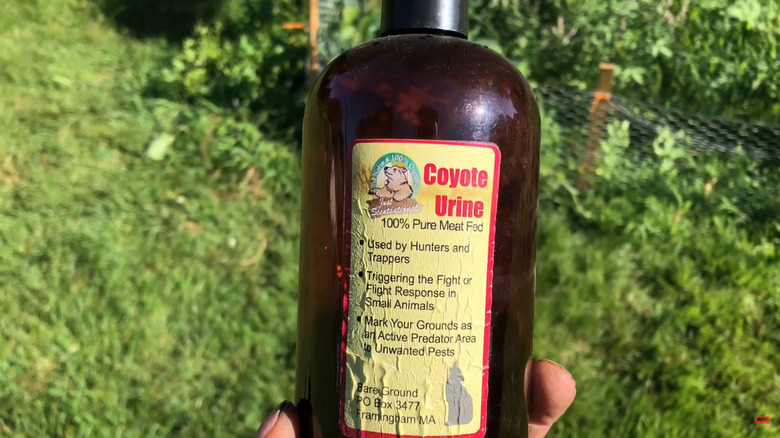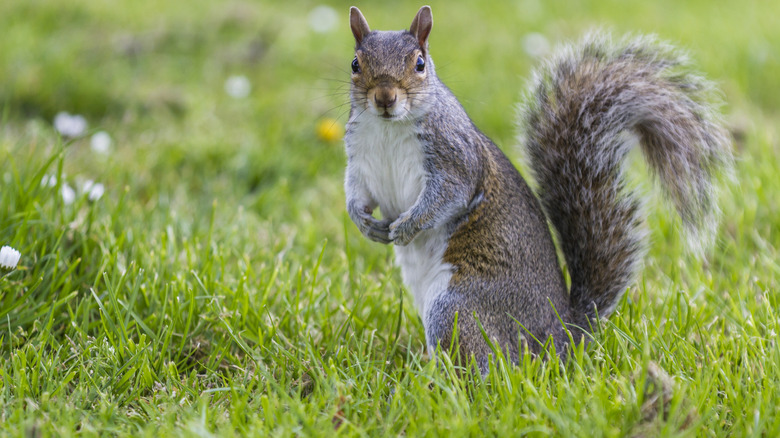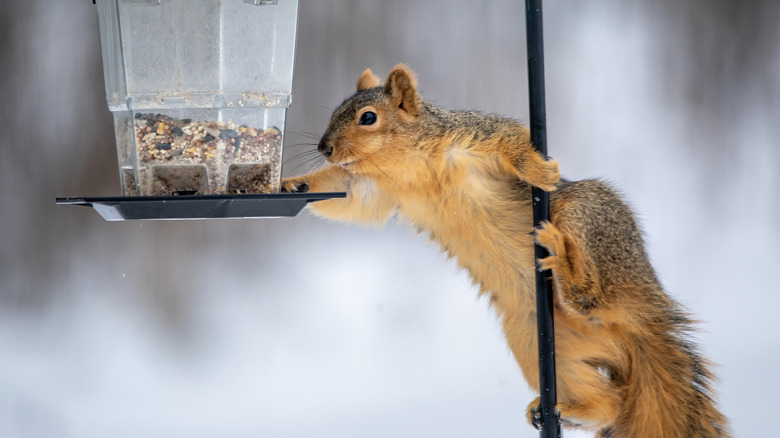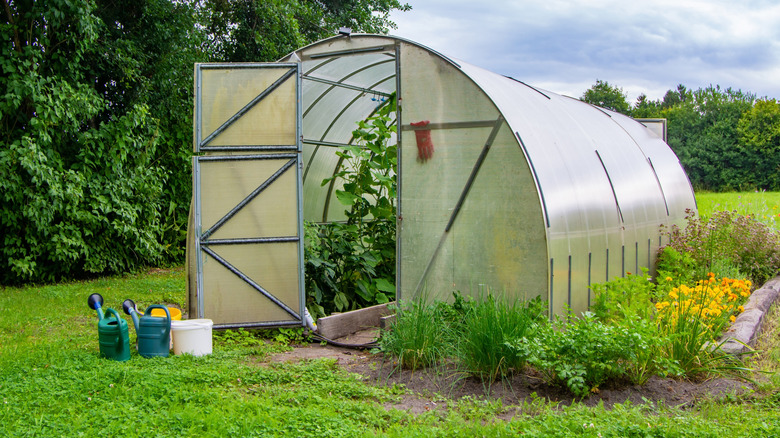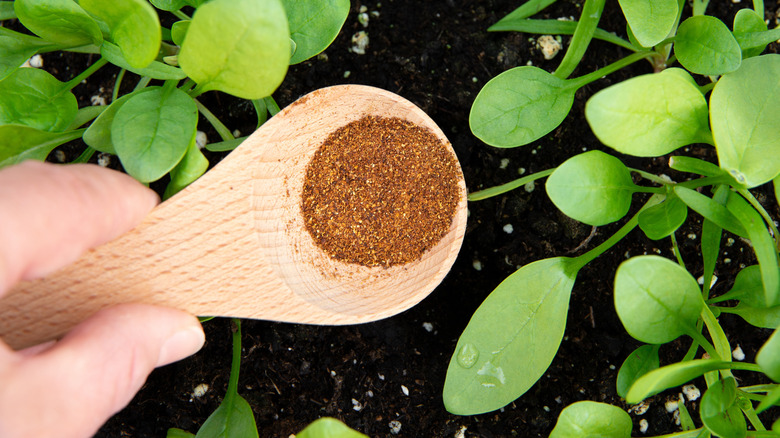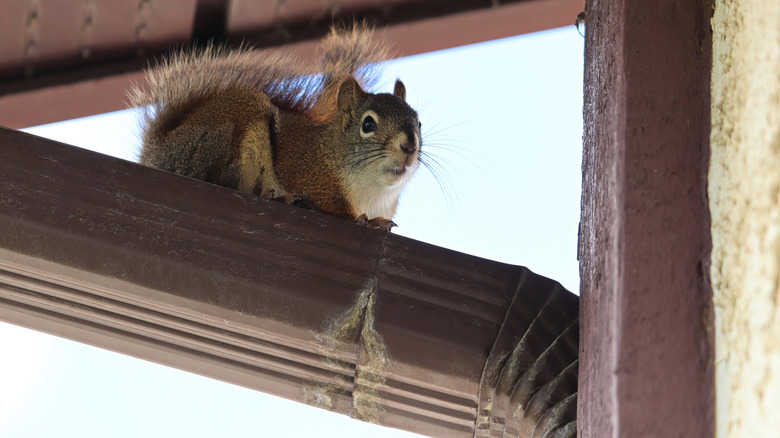12 Ways To Keep Trespassing Squirrels Off Your Yard Or Out Of The Garden
We may receive a commission on purchases made from links.
The presence of squirrels in North America is so widespread that it's nearly impossible to keep every single one of them away from your property at all times. However, there are plenty of things you can do to increase the likelihood that they will not be as interested in your place. This means being able to finally start growing a healthy garden that won't be ransacked by hungry critters, your trash cans and lawn furniture won't be chewed through, and the local birds will actually be able to enjoy the seeds you put out for them.
Some of these tips are longer-term, like changing out the flowers you have planted in your yard or building special fences. Others can be completed in a day or two, like reducing squirrel habitat around your yard so they don't feel as comfortable wreaking havoc. And some just take a few minutes (like washing out trash cans) but need to be repeated regularly. It might take some trial and error to see what your local scallywags respond to, as squirrels can be pretty intelligent and individualistic in their personalities, but there should be a combination that gets at least a few of them to go somewhere else.
Plant things they don't like to encourage disinterest
If your yard is full of plants that squirrels can't be bothered with, then they are less likely to spend time in it. For example, you might have heard that people plant daffodils to keep squirrels out of their garden. While a patch of daffs won't chase away squirrels, these critters aren't likely to eat daffodils because they contain a toxin called lycorine that makes most mammals feel sick. To ensure that you don't have bare patches in your borders and get an ongoing (squirrel-proof) show in spring, experts advise planting hyacinths and snowdrops that will bloom early in the spring, and ornamental onions (alliums) for flowers later in the spring in sunny beds. Varieties like Allium aflatunense, A. giganteum, A. karataviense, and A. moly can make good alternatives to tulips (whose bulbs are like squirrel magnets).
If you don't want to wait until next year for them to grow and flower, you can even purchase full-grown plants from your local garden center or nursery — even Amazon sells these Allium Serendipity, Ornamental Onions. Squirrels shouldn't eat these because they taste too much like onions, which they don't tend to like; however, the flowers come in many colors and are gorgeous for humans to enjoy looking at! If these plants don't suit your style, try crown imperial (Fritillaria imperialis), as the flowers tend to have an off-putting smell to squirrels. Plants with a big scent in general tend not to be as interesting to squirrels as well, like sagebrushes (Artemisia frigida and ludoviciana), as well as catmint.
Keep outdoor trash cans closed
Squirrels are scavengers, which means they are highly opportunistic eaters. If they can gain access to your outdoor trash storage, it's a bit like treating them to an all-you-can-eat buffet! While these pests don't have the dexterity and strength of a raccoon to open the top lid of the trash can, squirrels can actually be really smart, remembering things and rapidly figuring out where food is most likely to be. As rodents, their teeth also never stop growing, making them the perfect tool for gnawing through trash cans made of thinner plastics and helping themselves to whatever is inside. So, using a trash can that is pest-proof will discourage them from using your property as a food source.
If squirrels are getting into closed trash cans, something like the Suncast 33 Gallon Wicker-Style Hideaway Trash Can with Secure Latching Lid could help keep them out. It's made out of resin and is pretty thick, which might make it harder for squirrels to chew through than thinner options. Yet for the most tenacious squirrels, a latched trash can alone probably won't be enough, especially if it's emitting strong food smells. To make the can less attractive, it's recommended to clean the bins out between trash days. A good rinse with warm, soapy water will get rid of any lingering trash juice and will make squirrels less interested in what might be inside ... leading them to perhaps go and bother your neighbors instead.
Trim back your trees and shrubs
If your yard is an all-out squirrel paradise, they're going to hang around. One of the best ways to keep them from being so interested in your property is to think like a squirrel, at least for a moment. Consider all the places they might like to leap into, scurry and hide, make a nest, explore, etc. Then get rid of them! If you are having issues with squirrels getting from the yard to your home, one of the main dos of humane pest removal is to make your yard less hospitable to them. Start by trimming lower tree limbs (here's a guide on how to prune your trees the right way without calling a pro). Make sure no limb is within roughly 6 to 8 feet of your roof, so they can't make the jump.
Squirrels are smart, and might eventually find another way up (like scaling the bricks on your siding, or scurrying up the downspout), but it's still a good first step. Trimming back trees is also an important task for overall yard maintenance, so it's a win-win. Next, take a look at the rest of your yard, too. Are there shrubs that could be trimmed back or borders that could be neatened up so there are fewer hiding places for squirrels? Disorganized piles of wood, a dangerously dilapidated old shed that you've always meant to tear down? Cleaning up your yard isn't going to 100% get rid of every single squirrel, but you might start seeing less of them if they feel more exposed to danger.
Remove nesting options for them
If the squirrels of your neighborhood aren't able to make their nests on your property, they are less likely to hang around. Some species, like gray squirrels, don't tend to travel more than 200 yards from their nests for foraging, which would make your yard their main hangout area should they set up nests on your property. Therefore, it's worth taking preventative steps to make your home less accessible to squirrels to move them along. The first step is to seal off your attic. Vents, eaves, chimneys, broken windows, and the like all need to be taken care of. Be sure that the edges are heavily caulked for no gaps, and even the smallest of slats should have galvanized mesh across them, like this YardGard Chicken Wire, so they can't slip through and build a nest inside.
Once the gaps are sealed, consider making the entrance points to nesting spots even more inaccessible by covering up any wires in the area that the squirrels might use as highways. Cut open a plastic pipe and slip 2-foot sections around the wires. The pipe should be a little wider than the cords, at about 2-3 inches across. This way, when the squirrels try to scamper along the wires to get to your roof, the sections of pipe will spin, and they might get knocked off. By making nesting hard for them, the squirrels might be tempted to move on to somewhere where the task isn't as difficult.
Let dogs roam your yard
Dogs and squirrels are natural enemies, and predators and prey are always at odds with each other. Dogs with higher prey drives (like any sort of hound, terrier types, or a sporting dog breed) might especially love going after squirrels, as the animal's quick movement activates their instincts. If your dog is always in the backyard and makes a habit of chasing them, the squirrels are more likely to stay away. This is because over time, they'll begin to associate your yard with danger and steer clear. You don't need to sic your dog on them, per se, as this could have negative consequences for the dog, too (for instance, running after a squirrel when not in your yard and straight into danger — like in front of a car).
Instead, playing with your dog outside and letting them enjoy the yard multiple times a day will establish them as a predator in the area. Just keep in mind: if your dog is especially fast or determined, there's always a chance they might actually catch a squirrel. Have a plan in place for what to do if that happens, like humanely euthanizing the squirrel if it's been seriously injured, or taking it to your local vet for treatment.
Spread predator urine around your yard
Squirrels are nowhere near the top of the food chain in most ecosystems. In addition to having an actual predator in your yard, like a dog, you can scare squirrels into thinking there is an even bigger threat around by using a wild animal's urine. Coyotes are a prime example. Although it might sound a bit strange, you don't need access to an actual coyote to achieve this, either. Instead, it's easy enough to buy urine pre-bottled, like the Trap Shack Co. Coyote Urine. Don't use it on anything you intend to eat, like in a vegetable garden, or on particularly vulnerable plants. If dog pee or cat pee will kill it, so will coyote urine.
Best practice is to place it around your yard, particularly in the areas that you've noticed squirrels hanging out the most. Yet there is one important caveat: squirrels are smart and they might eventually figure out that there isn't really a coyote. So instead of reapplying the liquid every week, or after every heavy rain, it's best to use urine as a part of a larger pest control strategy. Only pull it out when it's really needed, so it'll actually make an impact. When used sparingly, and in conjunction with the other tips mentioned here, you are likely to have better success.
Use purpose-built squirrel repellent to put them off your yard
Animal repellents made with annoying lawn pests in mind are a great option to alternate with things like predator urine. These mixes are formulated so that pests don't like the smell or taste, and the best part is that they are often mostly natural. Many don't use harsh chemicals, but instead rely on natural options that the animals simply just don't like. While many aren't made for squirrels specifically, professionals insist that they still do the job. For example, something like Bobbex-R Small Animal Repellent may not only put squirrels off visiting your lawn, but also rabbits, groundhogs, chipmunks, and voles, too.
This product, in particular, not only smells nasty to pests, but also tastes bad, too — making it doubly effective. It has meat meal, fish oil, putrescent eggs, and garlic in it, which the animals don't like. If you're exploring other brands, take a close look at the ingredients. Look for those same key components, or anything that smells and tastes equally unappealing to animals. The stronger the sensory offense, the more effective the repellent will be.
Protect your bird feeder
Squirrels love eating food that's not meant for them! It really seems to be one of their most favorite things. This can be tough when you've also tried very hard to turn your yard and garden into a bird haven, as squirrels are adept at breaking into bird feeders. Fortunately, there are ways to ensure your birdseed doesn't become squirrel snacks, and if the squirrels aren't able to feast at your feeder, they might go hang out in your neighbor's yard instead. To start, you can modify the feeders you already have to make them harder to get into, or purchase ready-made squirrel-proof feeders. This Niser Squirrel-Proof Bird Feeder works on a weight system. The access to the seed is connected to a perch on a spring. Heavier squirrels will weigh down the perch, closing the slot to the seed. The Buteafly Metal Wild Bird Seed Feeder is similar, but has two larger perches instead. To make the feeders you already own harder to get to, you can hang them (or put them on a slender pole) at least ten feet from anything the squirrel might use as a launching pad. You can also try using a baffle to protect existing bird feeders, such as the Woodlink Audubon Wrap Around Squirrel Baffle for pole-mounted feeders or the Kitvona Outdoor Squirrel Baffles for hanging ones.
As mentioned, however, squirrels are endlessly tenacious and intelligent. Making your bird feeders harder to get into might just feel like a challenge for them. And one that they're determined to conquer at that. So, as an added layer of protection, consider using seeds that birds love, but squirrels don't. Thistle seed and safflower tend to top the list, and there are plenty of pre-packed options specifically for this purpose, like Wild Delight Advanced Formula Squirrel Away.
Put up a barrier around your vegetable garden
A vegetable garden or a fruit tree is basically like a siren song for squirrels. If there were fresh food available for free, you likely would stop by, too! The only way to keep trespassing squirrels away from your garden is exclusion. Don't just grow more food thinking that squirrels will just eat some and leave the rest for you. Instead, they will keep coming back and bring along their friends, too. This isn't a sharing situation — you have to stop the buffet.
You can use chicken wire and netting, like Meuallikit Garden Netting Ultra Fine Insect Netting for Plants, Trees, Vegetables, to keep hungry pests of all kinds away from your fruits and vegetables. This way, they can't scamper up from the ground or climb in over the top. Even if they can, they won't be able to reach the food. For the long term, you might even consider an aviary of sorts for your outdoor garden, like the DWVO Polycarbonate Greenhouse, or a DIY version that is similar. Just avoid pre-made options that only have tarp or other thinner materials for siding, as determined squirrels could definitely chew through that without a second thought, making the structure functionally useless.
Try capsaicin (spice) on things they might eat
Another way you can protect feeders is with capsaicin. Capsaicin doesn't bother birds, but squirrels don't like eating it because it's too hot for them. It's what gives chili powder its heat. So, if the seed in your bird feeders, or the feeders themselves, is covered in it, squirrels might be more likely to leave things alone because it burns. You can also try coating the leaves of plants you want left alone with the material to ward off pests, as capsaicin is registered for use as a rodenticide.
There is always a caveat, however. Using chili powder on vegetables and plants could have adverse effects on non-target animals, like bees, as well. If you put it in the soil (perhaps to protect bulbs), you run the risk of disrupting beneficial insects. You also might cause harm to your pets, as cats or dogs can easily pick up the powder on their paws, then get it into their eyes or mouths while grooming. This can cause pain and discomfort. To avoid this, be sparing in where you sprinkle the powder, zeroing in on areas that have a real appeal to squirrels.
Try chasing squirrels out of crawl spaces and attics with an ultrasonic strobe light repeller device
If you have squirrels nesting in your attic or under your home in the crawl space, chances are they're also raiding your yard daily! Getting squirrels out of your attic is a critical first step to stopping the damage outside, too. While sealing these places up is a great step for future prevention, you need to get the animals out, first. One humane and increasingly popular method is using ultrasonic strobe light repeller devices. These gadgets combine high-frequency sound with flashing lights. These are two things squirrels find both disorienting and unpleasant. When placed in an attic or crawl space, the device creates an environment so uncomfortable that squirrels will often relocate on their own.
While more research is still being done, some sources suggest strobe lights show real promise in pest deterrence. For the best results, choose a device that has both sound and light features, and make sure to follow the directions for where to put it so you get the most coverage. Be sure to read any available reviews first and look for a machine that other buyers have found effective. For example, the reviews for the 360° Ultrasonic Rodent Repellent Device Indoor Plug in indicate that many homeowners have seen a noticeable drop in squirrel activity after installation.
Add baffles or flashing to tree trunks
When cleaning up your yard, an easy thing to do for further squirrel-proofing is to add baffles and flashing to your tree trunks. Baffles are often shaped like an upside-down bowl, cone, or tube. They're intentionally slick and angled to prevent squirrels from getting a grip or climbing past. They're usually installed about midway between the ground and first branches, so animals can't jump over them from below. You can DIY them with plastic or fashion regular flashing into cone shapes. Baffles are probably best-suited to younger trees with slimmer trunks.
Adhering flat flashing to trees is a little bit less visually obtrusive, but works in a similar way, and is ideal for larger trees. The smooth material wrapped around the trunk makes it near impossible for squirrels to get a grip. To protect the tree, flashing should never be nailed or stapled directly into the bark. Instead, it's best to attach it with adjustable wire or straps that allow for tree growth and don't cause damage. You can DIY this using metal flashing, or get a kit like this Wrap Around Squirrel Baffle for Trees from Mainline Materials.
